
I feel for Afeela. Or, more accurately, for Sony Honda Mobility, its maker.
It is entering a difficult market for both EVs and sedans with an all-new electric sedan priced to compete at the high end of the segment alongside more established brands such as BMW, Mercedes-Benz, Tesla, and Lucid.
And it’s main selling point seems to be its load of electronic goodies, not any particular prowess as an automobile.
Sony Honda is promising up to 300 miles of range and a dual motor, all-wheel drive powertrain delivering “approximately 483 horsepower” (I’ve never figured out how a precise number is an approximation). But that doesn’t lead the large luxury sedan segment. Lucid’s least-efficient sedan delivers an EPA estimated 406 miles with a 620-horsepower all-wheel drive system. The base Tesla Model S comes in at 670 hp and 400 miles.
And the Afeela, while decked out with a NACS charging system to take advantage of Tesla Superchargers, can only take on electrons at any DC fast-charge station a maximum rate of 150 kilowatts per hour. It’s sufficient to take the Afeela’s 91 kWH battery pack from 80% empty to 80% full in about half an hour if everything is working at maximum capacity, but that’s par for the segment – although some of those competitors are replenishing larger capacity batteries. But it still means spending a few minutes more tat the charging station that with several other EVs – some boasting DC recharge speeds of up to 225 kW.
Afeela’s Competition
In addition to the Lucid Air, Mercedes-Benz EQS and Tesla Model S sedans, other all-electric premium and luxury sedans that Sony Honda’s target audience is likely to be cross-shopping are the BMW i7, Audi A6 Quattro, and Genesis Electrified G80. The Audi, Genesis, Lucid and Tesla all have lower starting prices and offer more range. The entry fee for the all-wheel drive versions of the Mercedes and BMW large luxury sedans is a bit higher than for the Afeela Signature, but they offer a bit more range.
Nothing New Here
Unfortunately, while the Afeela is packed with tech, it doesn’t seem to offer much in the way of groundbreaking electronics.
Despite all its sensors (up to 40 of them), the driver assistance and safety systems, for instance, can combine to offer only Level 2+ “partial” automated driving, which is what most of the competition provides.

Mercedes-Benz, though, has Level 3 “conditional” automated driving in the EQS sedan in the U.S. In states that permit it (California and Nevada, so far) it allows hands off the wheel and eyes off the road but still requires driver awareness of surroundings and readiness to take over at any time. BMW has Level 3 in the 7-Series in Europe and Honda offers it in the Legend in Japan.It’s not until you hit Level 5, though, that you truly have autonomous driving in which the driver is merely a passenger.
Level 2+ autonomous permits hands-free operation but requires that the driver be aware of what’s going on – eyes on the road, not buried in a book or watching a video – and ready to take back control of the car at any time. We expect, though, that Afeela will be able to jump to Level 3 with an over-the-air software update when the time is right, and if the launch is successful.
Note, please, that my song may change after (if) I get a chance to try out an Afeela.
So far as I can tell nobody outside the company has yet tested one. It’s only by driving a vehicle and experiencing the interaction of all it’s components – mechanical and electronic, performance and comfort – that a real critique can be formed.
When, and How Much?
The all- electric Afeela 1 is due to start production next year with customer deliveries of the $102,900 Afeela 1 Signature slated to start in mid 2026. Initially it will be a California-only car. The more basic $89,900 Afeela 1 is due in 2027 and we’re not sure if it will be available outside of California by then. You can place an order now for the either version for a fully refundable $200.
They will be built alongside Honda EVs at that company’s Ohio manufacturing plant, so no imported car tariff although it will use a lot – repeat, a lot – of electronics imported from Japan, and these are subject to tariff costs. So far, Sony Honda Mobility, the joint venture responsible for the Afeela, hasn’t said anything about tariff impact on pricing.
Nor has the company – we’ll call it SHM from now on – deigned to reveal how many, or few, reservations it has received.
There are really nice folks showing it off at a few pop-up locations around California and they really want to help you understand this collaborative car.
The Sony Stuff
But during my recent visit to the Afeela “studio” in the Century City mall in Los Angeles, it was apparent that they knew a lot more about the Sony content than whatever Honda has contributed to the deal. It felt like I was shopping for a large electronic device rather than an automobile.
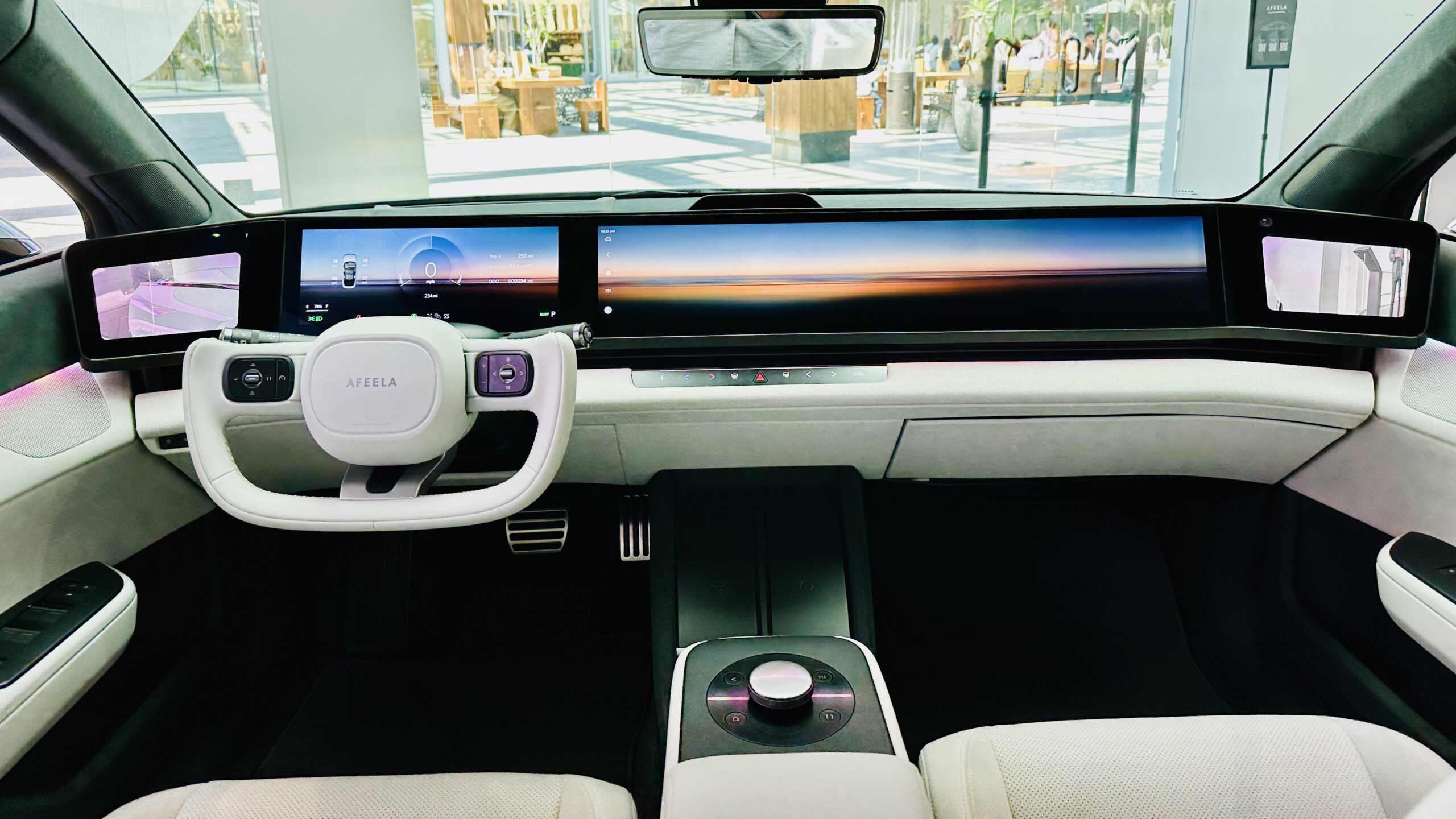
And bummer, in order to make use of the key tech that’s loaded into the Afeela you’ve got to purchase a number of subscription services – and keep renewing them – after the initial three-year free period.
To be fair, I was there on a press-only day and was probably not being exposed to the studio’s regular staff, but still…
The handout highlighting the Afeela’s key features lists these items before any vehicular specs:
- Media Bar, a lighted, programmable digital display across the front”fostering engagement between the vehicle and its surroundings”
- Afeela Personal Agent, an AI-driven virtual assistant the works with natural voice instructions, learns driver preferences and provides recommendations for navigation, entertainment and vehicle settings. Reqiuires ongoing subscription after third year.
- Creative Entertainment Space, featuring Sony 360 Spatial Sound and individual screens for each passenger – two rear, one front -for in-car entertainment such as music, gaming and movie watching.
- Intelligent Drive, with up to 40 sensors including 18 cameras, a Lidar, 9 radars and 12 ultrasonic sensors, all to enable real-time monitoring of the surrounding environment to facilitate and enhance driver assistance systems such as lane following and centering, to improve response time for collision warning and mitigation systems and to ensure the best possible route selection for the navigation system. Requires subscription after year three.
Additionally, the doors open when the driver approaches – if she’s carrying the NFC key fob or a smart phone with the Afeela app that includes a digital key. Doors close automatically when the driver sits and mashes the brake pedal. SHM calls it a “touchless on-boarding experience.”
There will be individual video screens for the back seat passengers and a portion of the central screen up front can be converted to a video screen for the front passenger, with a screening system to prevent the driver from watching the move or video game instead of the road. PlayStation 4 remote can be set up as can a number of music, video, gaming and services apps.
Sony does make good electronics and Honda does make good cars. So we’ll see.
OK, Back to Afeela, the Car
It is a large five-seat sedan, with lots of room up front and decent backseat acreage, although not as much as you’d get in a similarly priced Lucid Air.
Full specs and measurements aren’t available yet, but the Afeela has said that cargo capacity behind the rear seat measures an impressive 27 cubic feet of cargo capacity, which appears to be segment-leading. The similarly priced Lucid Air offers 22.1 cubes and the Mercedes-Benz EQS has 21.5 cubic feet. Each of the latter can easily handle about half-a-dozen carry-on bags, while the Afela might stretch to seven. Laying down the rear seat backs – and in the Afeela they do lay pretty flat – more than doubles the size of the cargo floor.
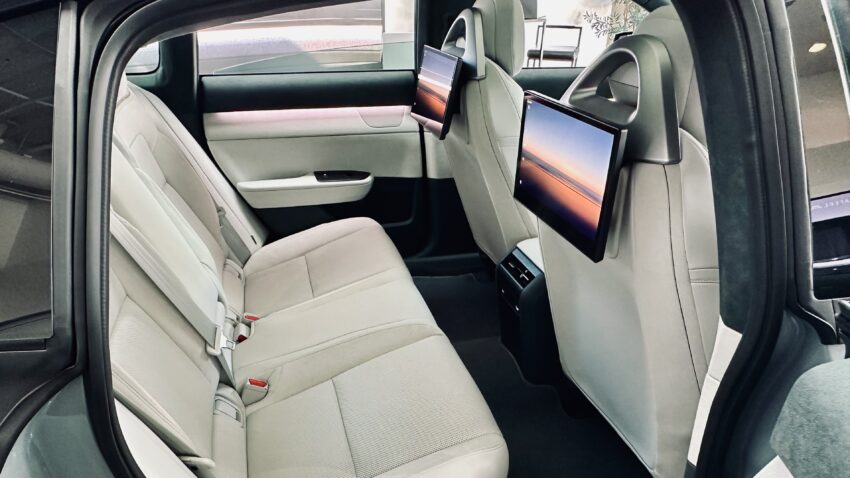
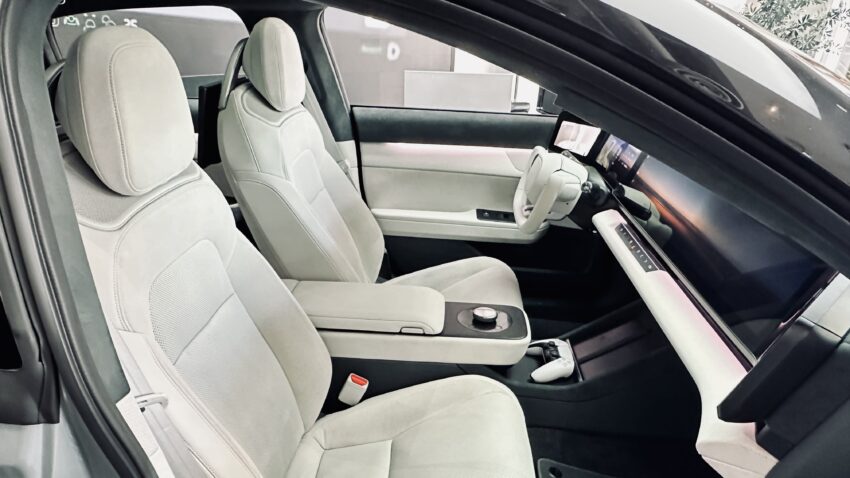
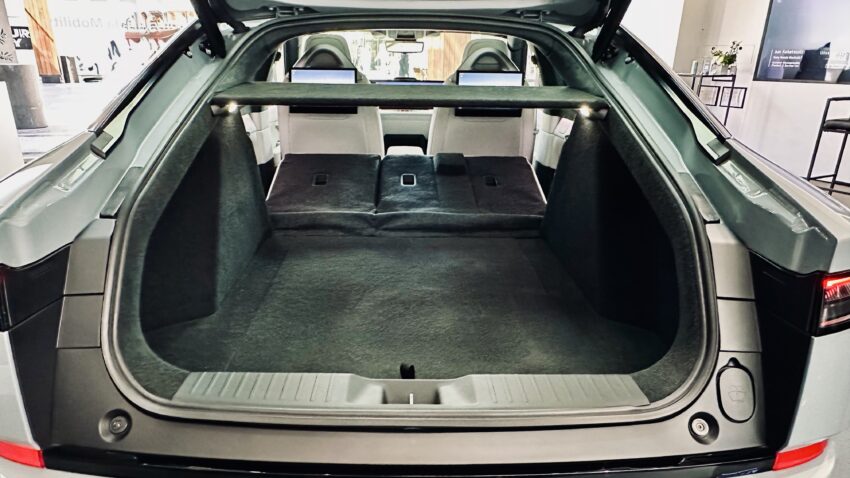
SHM’s designers gave the Afeela 1 as a fairly conventional sedan-like profile with a sharply sloping fastback-style roof line that flows into stubby rear deck (the while thing opens like a hatchback).
Looks are as pretty subjective thing – I didn’t particularly car for the overall exterior design, but certainly didn’t hate it. The Afeela’s shape is vaguely reminiscent of the third-generation (1996) Ford Taurus – ovals was the theme then and are now.
The Afeela’s nose is curved and bereft of chrome but sports a digital display panel – the Media Bar – between headlamp housings. It can be programmed to display stuff like an animated cartoon, a light display, your company name, a cheery daily hello or whatever else you’d like – within what’s legal to display publicly, I’d guess.
When I arrived at the studio, the panel lighted with a cheery “Welcome John” (although I was there with another auto writer, also named John, so maybe it was greeting him).
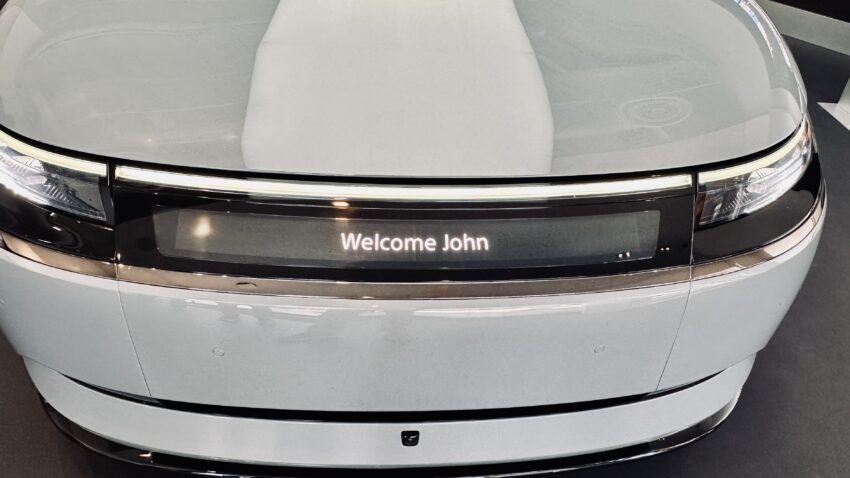
There are no visible door handles, and while the Signature gets 21″ wheels that nicely fill the wheel arches, the Origin comes with 19 inchers that don’t do much for the overall look.
The Afeela is packed with sensors and designers had to create a trio of pods at the leading edge of the roof – one in the center and one on each side – to house those charged with looking ahead. It was done to ensure clearance over tall trucks and SUVs, but it doesn’t do much for appearance. It’s better than one of Waymo’s self-driving Jaguars, but still a bit lumpy looking.
We don’t know how it handles or how comfortable and quiet it is. We have been told it will come with air suspension, and wider rubber on the rear wheels than up front.
We do know it looks okay on the outside, better in person than in photos, and has a clean and tidy interior with a thin wall-to-wall screen display covering the entire upper dash and part of the upper front doors, just below the leading edge of the side windows.
The entire array measures 42.5 inches in width (but is only about 6 inches in height), and includes a 12.3-inch digital driver info screen, a 16.2-inch main or center screen, 7-inch digital displays for the side mirror cameras on end. The ceiling-mounted rear view mirror can be used as a real mirror or switched over to a digital display through a rear-facing camera for a wider field of vision. Homelink is apparently standard, at least on the Signature trim.
Steering is via a “U”-shaped yoke and there here are physical controls for the climate system and door lock and windows, but most other controls are accessed via the touchscreen, voice-command or buttons on the two spokes that secure the yoke to the steering column.
The base Origin model will come in one one standard color scheme – black on black on black (even the wheel covers).
The Signature will offer a number of exterior colors and additional options to make it a little more customized to owners’ tastes.
Oh, that Name!
Now, about “Afeela.”
SHM says Afeela is an acronym of sorts, that the car is designed to “create a feeling” and to highlight automation and autonomy – so it’s A for Automation, then Feel, for feeling, and finally, A for Autonomy.
The name represents – and they actually have this in writing, “an interactive relationship where people ‘feel’ mobility as an intelligent entity, and mobility ‘feels’ people and society using advanced technologies such as sensing and networking.”
On the Afeela “product” website, the opening photo is of a young man, obviously seated at the wheel of a car although we can’t see what kind of car. His bearded face looks a bit morose and a stream of tears is rolling down one cheek. Later in the short video, he’s driving an Afeela 1 with a broad smile on his mug. Feelings.
Whoof!
So now you know – and you can disregard those reports that say its is, or is derived from, a Japanese word.
Whatever you might think about the name, it already is engendering lots of wordplay and jokes on line. Among the best I’ve seen are “Afeela the name could be better.” There’s also the racier “if there’s police version, will it be the Cop Afeela?”
We’re open to more suggestions.
